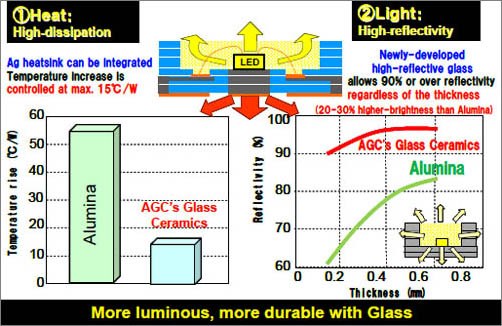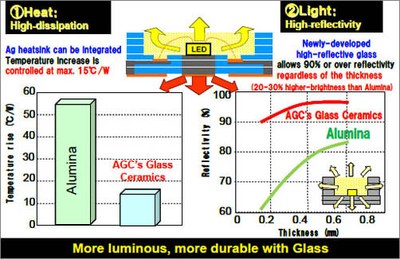AGC Releases Glass-ceramics Substrate for High-power LED Lighting
In July 2010, AGC (Asahi Glass Co., Ltd.) will start sales of a new glass-ceramics substrate that enables high-brightness and high-durability for LED lighting. This new glass-ceramics substrate will expand LED applications in the lighting and illumination sector, including 3D televisions and automotive lighting, in which high-power output is increasingly in demand.
Starting the volume production at a newly-built factory in Taiwan, AGC aims to achieve a market share of 20% or over in the glass-ceramics substrate market for high-output LED lighting, which is expected to grow into a 100-billion-yen market by 2020.
So far, LED applications have been limited primarily to products with extremely small power output, such as liquid crystal display televisions and home interior lighting. In the future, however, the demand trend is expected to shift toward high-output LED applications that require high-brightness, such as 3D televisions, automotive headlights and other automotive lighting, and outdoor lighting and illumination.
In addition to high-brightness, high-durability is also a prerequisite for high-output LED applications as heat generation becomes greater as the power output increases. Conventional resin substrates are susceptible to high temperature and are not considered suitable for high-output LEDs. In contrast, alumina substrates are heat-resistant, but the reflectivity deteriorates over time as the silver reflective film, which is used for enhancing high-brightness, becomes sulfurated over a prolonged period. In addition, due to the poor moldabiliy, alumina substrates are considered to have only limited usage.
AGC's new substrate that is created through the integration of our glass technology and ceramics technology enables both high-brightness and high-durability for high-output LEDs, and has excellent moldability into compact shapes. The product features are as follows.
1) High-brightness: High-reflectivity enhanced the brightness by 20%-30% as compared to alumina substrates(reflectivity varies depending upon the thickness of the substrate)
2) High-durability: Excellent heat dispassion design allows higher heat dispassion rate than alumina substrates. Also, the reflectivity does not deteriorate over a prolonged period.
3) Excellent moldability: Excellent moldability enables a compact and complex cavity structure.
Leveraging our strengths, AGC is determined to move into the field of LED lighting and various other next-generation lighting materials, and introduce new products to the market at an accelerated pace.
For details visit http://www.agc.co.jp/english/news/2010/0616e.pdf



